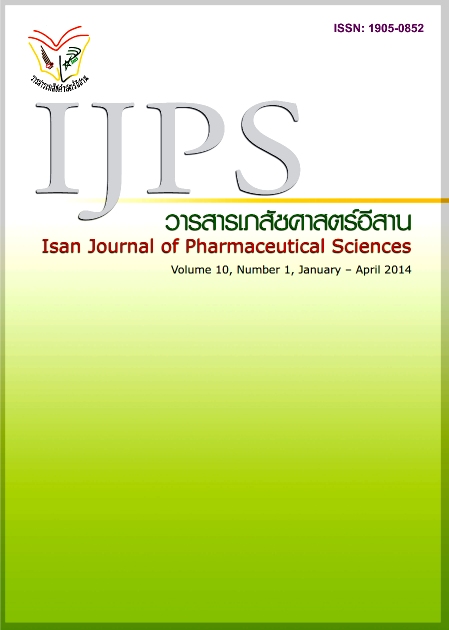Induction of Non-Alcoholic Fatty Liver Disease in Mice
Main Article Content
Abstract
Nonalcoholic fatty liver disease (NAFLD) is a metabolic syndrome in which excess fat accumulates in the liver without history of alcoholic abuse. NAFLD is the most frequent cause of liver damage which is classified into steatosis, steatohepatitis, and may progress to liver cirrhosis and hepatocellular carcinoma.
Induction of hepatic transformation in mice manipulates by stimulating imbalance between lipid catabolism
and free fatty acid reabsorption resulting in accumulation of fat especially triglyceride in the liver with hepatic pathophysiology and histopathology as that in human. The animal models of NAFLD are divided by NAFLD-inducible methods into 2 patterns, namely genetic modified and dietary supplement models. The genetic modified models are mice which have been configured or knocked out lipid synthesis related gene(s) including transgenic SREBP-1c, ob/ob, db/db, KK-Ay, PTEN10 null, PPAR-a knockout mice. On the other hand, the dietary supplement models are inducible by several patterns of diet, i.e., methionine and choline deficient food, high fat diet, cholesterol and chocolate, or fructose. The progress or development of NAFLD in each mouse model depends on the method and period of induction. Hence, the progress of NAFLD mice employed should be accordingly considered to the research objectives to achieve a precise and accurate result, and effectiveness of the outcome.
Article Details
In the case that some parts are used by others The author must Confirm that obtaining permission to use some of the original authors. And must attach evidence That the permission has been included
References
Abiru S, Migita K, Maeda Y, et al. Serum cytokine and soluble cytokine receptor levels in patients with non-alcoholic steatohepatitis. Liver Int 2006; 26: 39–45.
Ackerman Z, Oron-Herman M, Grozovski M, et al. Fructose-induced fatty liver disease: hepatic effects of blood pressure and plasma trigly ceride reduction. Hypertension 2005; 45(5): 1012-1018.
Angulo P. Nonalcoholic fatty liver disease. N Engl J Med 2002; 346(16): 1221-1231.
Angulo P, Keach JC, Batts KP, Lindor KD. Indepen dent predictors of liver fibrosis in patients with nonalcoholic steatohepatitis. Hepatology 1999; 30(6): 1356-1362.
Armutcu F, Coskun O, Gürel A, et al. Thymosin alpha 1 attenuates lipid peroxidation and improves fructose-induced steatohepatitis in rats. Clin Biochem 2005; 38(6): 540-554.
Anstee QM, Goldin RD. Mouse models in non-alco holic fatty liver disease and steatohepatitis research. Int J Exp Pathol 2006; 87(1): 1-16.
Bray GA, York DA. Hypothalamic and genetic obesity in experimental animals: an autonomic and endocrine hypothesis. Physiol Rev 1979; 59(3): 719-809.
Caldwell SH, Swerdlow RH, Khan EM, et al. Mito¬chondrial abnormalities in non-alcoholic st¬eatohepatitis. J Hepatol 1999; 31: 430-434.
Chavin KD, Yang SQ, Lin HZ, et al. Obesity induces expression of uncoupling protein-2 in hepa¬tocytes and promotes liver ATP depletion. J Biol Chem 1999; 274(9): 5692-5700.
Chen H, Charlat O, Tartaglia LA, et al. Evidence that the diabetes gene encodes the leptin receptor: identification of a mutation in the leptin receptor gene in db/db mice. Cell 1996; 84(3): 491-495.
Debaere C, Rigauts H, Laukens P. Transient focal fatty liver infiltration mimicking liver metas¬tasis. J Belge Radiol 1998; 81(4): 174-175.
Deng QG, She H, Cheng JH, et al. Steatohepatitis induced by intragastric overfeeding in mice. Hepatology 2005; 42(4): 905-914.
Dixon JB, Bhathal PS, O’Brien PE. Nonalcoholic Fatty Liver Disease: Predictors of Nonal¬coholic Steatohepatitis and Liver Fibrosis in the Severely Obese. Gastroenterology 2001; 121(1): 91–100.
Fan CY, Pan J, Usuda N, Yeldandi AV, Rao MS, Reddy JK. Steatohepatitis spontaneous peroxisome proliferation and liver tumors in mice lacking peroxisomal fatty acyl-CoA oxidase: implications for peroxisome prolife rator-activated receptor alpha natural ligand metabolism. J Biol Chem 1998; 273(25): 15639-15645.
Giugllono D, Paolisso G, Cerillo A. Oxidative stress and diabetes vascular complication. Diabetes Care 1996; 19(3): 257-267.
Grattagliano I, Caraceni P, Calamita G, et al. Severe liver steatosis correlates with nitrosative and oxidative stress in rats. Eur J Clin Invest. 2008; 38(7): 523–530.
Hashinaga T, Wada N, Yamada K, et al. Transgenic mice expressing nuclear sterol regulatory element-binding protein 1c in adipose tissue exhibit liver histology similar to nonalcoholic steatohepatitis. Metabolism 2007; 56(4): 470-475.
Horie Y, Suzuki A, Kataoka E, et al. Hepatocyte specific Pten deficiency results in steato¬hepatitis and hepatocellular carcinomas. J Clin Invest 2004; 113(12): 1774-1783.
Hug H, Strand S, Grambihler A et al. Reactive oxygen intermediates are involved in the induction of CD95 ligand mRNA expression by cytostatic drugs in hepatoma cells. J Biol Chem 1997; 72(45): 272-281.
Inayat-Hussain SH, Couet C, Cohen GM, Cain K. Processing/activation of CPP32-like proteases is involved in transforming growth factor beta1-induced apoptosis in rat hepatocytes. Hepatology 1997; 25(6): 1516-1526.

